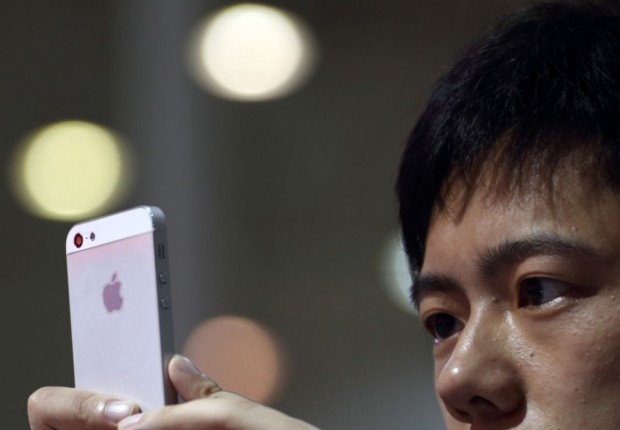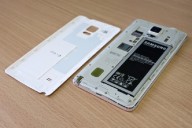Apple Inc. haggled for six years to clinch a deal to sell the iPhone through China Mobile Ltd. The quest to win holdout customers in the world’s most populous country is far from over.
The deal, announced yesterday, gives Cupertino, California-based Apple access to China Mobile’s 763 million subscribers at a time when 90 percent of new mobile-phone purchases in China are smartphones. It also paves the way for Apple to battle market-share leader Samsung Electronics Co. in one of the fastest-growing markets.
Even so, the partnership with China Mobile doesn’t guarantee Apple a prolonged boost. Forrester Research projects the deal will lift Apple’s smartphone market share in China by just three percentage points to 8 percent. IPhones — including the new lower cost iPhone 5c — remain too expensive for most customers in a country where competitors offer cheaper alternatives with in-demand bigger screens. Other hurdles facing the iPhone include the limited rollout of China Mobile’s high-speed network, a scarcity of apps compared to other handsets and a dearth of Apple-owned retail outlets.
“It’s not as if everyone in China is desperately waiting for an iPhone,” said Benedict Evans, an analyst with Enders Analysis in London. “Even the iPhone 5c is seriously expensive in the Chinese market.”
Under Pressure
The agreement with China Mobile comes as Apple looks to reignite growth after its first annual profit decline in at least a decade. As the market for the most expensive smartphones becomes more saturated in the U.S. and other developed nations, China is critical for Apple. In the fiscal year ended in September, the company generated $27 billion in sales in what it calls Greater China, which includes Hong Kong and Taiwan, up 14 percent from a year earlier.
“China is an extremely important market for Apple and our partnership with China Mobile presents us the opportunity to bring iPhone to the customers of the world’s largest network,” Apple Chief Executive Officer Tim Cook said in the statement announcing the China Mobile deal. The company declined to comment further.
Apple shares rose 3.8 percent to $570.09 at the close in New York in the biggest one-day gain since Sept. 23, buoyed by news of the deal. Under the agreement, iPhones will become available in China Mobile stores starting Jan. 17.
Focused Strategy
Apple could use a boost in China, where it has faced declining market share as it only had distribution deals with smaller carriers China Unicom (Hong Kong) Ltd. and China Telecom Corp. and its handset didn’t support China Mobile’s homegrown third-generation standard. The iPhone maker ranked fifth with 6 percent of China’s market during the third quarter, researcher Canalys said in November.
Yet with the China Mobile deal, Apple isn’t going after market share, said Evans. Apple’s strategy is to attract wealthier customers who can afford an iPhone, letting the company maintain its industry-leading profit margins. Getting about 2 percent of China Mobile’s customers equates to about 20 million new iPhone sales, according to Deutsche Bank AG. Adding the iPhone on China Mobile will particularly challenge Samsung’s leadership for high-end smartphone sales.
Samsung had 21 percent of China’s market in the third quarter, up from 14 percent two years ago, according to Canalys.
“This agreement will affect Samsung the most because, along with Apple, they are in the class of high-end smartphones that are an aspiration play in China,” Shaun Rein, managing director of China Market Research Group in Shanghai, said in a phone interview. “Some of the China Mobile users who had bought Samsung before, due to a lack of premium choices, will now switch to Apple.”
Numerous Hurdles
Apple’s partnership with the largest carrier will mean Samsung must take steps like boosting marketing, said TongYang Securities Inc. analyst Park Hyun.
Still, Apple’s targeted strategy faces challenges in China. That includes the iPhone’s cost, which starts at the equivalent of more than $700 for the 5c, or double the average monthly wage in China. Competitors with handsets running Google Inc.’s Android software, including Samsung, Lenovo Group Ltd., and China Wireless Technologies Ltd. offer phones at cheaper prices. A smartphone from Xiaomi Corp. is available for about $135, said Evans.
“Price is the number one challenge,” said Bryan Wang, principal analyst and country manager in China for Forrester. “You’re looking at $600 and above for the iPhone and that is significantly higher than the average selling price for Android devices.”
‘Key Variable’
Apple and China Mobile didn’t disclose pricing details in their announcement. Customers in China often don’t get a subsidy that cuts the price of the iPhone like they do in the U.S. Still, China Mobile last week said it will boost handset subsidies next year, as it plans to sell as many as 220 million smartphones in 2014, compared with 155 million this year.
“The pricing is the key variable,” said Michael Walkley, an analyst with Canaccord Genuity. “If China Mobile gives an attractive subsidy, that could lead to higher sales.”
China Mobile doesn’t disclose subsidies on specific devices, Rainie Lei, a Hong Kong-based spokeswoman said in an e-mail. China Mobile will implement “a prudent, rational mobile phone subsidy policy” next year, she said, without supplying details.
Read more: Apple Hurdles in Top Market Endure After China Mobile















No Comments